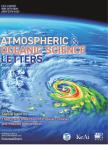版权所有:内蒙古大学图书馆 技术提供:维普资讯• 智图
内蒙古自治区呼和浩特市赛罕区大学西街235号 邮编: 010021

作者机构:State Key Laboratory of Atmospheric Boundary Layer Physics and Atmospheric Chemistry (LAPC) Institute of Atmospheric PhysicsChinese Academy of Sciences Beijing 100029 China
出 版 物:《Atmospheric and Oceanic Science Letters》 (大气和海洋科学快报)
年 卷 期:2011年第000卷第6期
学科分类:07[理学] 070601[理学-气象学] 0707[理学-海洋科学] 0706[理学-大气科学]
主 题:diurnal temperature range greenhouse gases anthropogenic aerosols aerosol direct effect
摘 要:This study investigates the changes in January diurnal temperature range (DTR) in China during 1961- 2000. The observed DTR changes during 1981-2000 relative to 1961-80 are first analyzed based on the daily temperature data at 546 weather stations. These observed DTR changes are classified into six cases depending on the changes in daily maximum and minimum temperatures, and then the occurrence frequency and magnitude of DTR change in each case are presented. Three transient simulations are then performed to understand the impact of greenhouse gases (GHGs) and aerosol direct forcing on DTR change: one without anthropogenic radiative forcing, one with anthropogenic GHGs, and another one with the combined forcing of GHGs and five species of anthropogenic aerosols. The predicted daily DTR changes during the years 1981-2000 are also classified into six cases and are compared with the observations. Results show that the previously proposed reason for DTR reduction, a stronger nocturnal warming than a daytime warming, explains only 19.8% of the observed DTR reduction days. DTR reduc- tions are found to generally occur in northeastern China, coinciding with significant regional warming. The simu- lation with GHG forcing alone reproduces this type of DTR reduction with an occurrence frequency of 32.9%, which is larger than the observed value. Aerosol direct forcing reduces DTR mainly by daytime cooling. Consideration of aerosol cooling improves the simulation of occurrence frequencies of different types of DTR changes as compared to the simulation with GHGs alone, but it cannot improve the prediction of the magnitude of DTR changes.